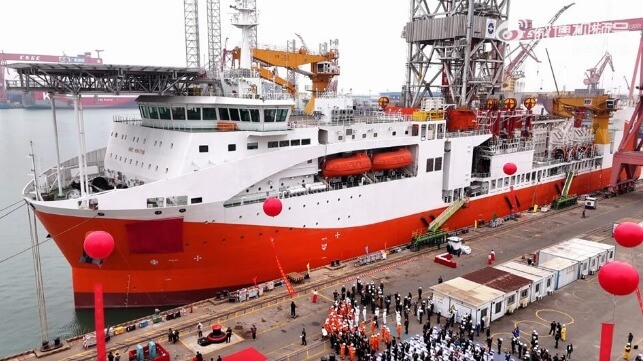China Begins Sea Trials for its First Ultra-Deep Drilling Ship

China has begun sea trials for its first domestically-built ultra-deep ocean drilling ship. Officials are boasting that it is one of the most sophisticated vessels in the world while reporting it will be used for oil and gas drilling as well as “scientific exploration.”
The naming ceremony and dedication for the vessel named Meng Xiang (which means dream in Chinese) took place on Monday and the vessel was due to commence its sea trials. The ship, which is approximately 33,000 gross tons, was built by Huangpu Wenchong, part of CSSC, which also oversaw its design with the 708 Research Institute. Only a few details were released about the vessel, including it has an overall length of approximately 590 feet (190 meters). Its maximum drilling depth is reported to be 11,000 meters (6.8 miles) below the surface.
The ship is said to have a broad range of industry-leading characteristics. It was designed for extended time at sea with trips planned for up to 120 days. It also has the ability to travel 15,000 nautical miles during each assignment and can withstand Category 16 typhoon sea conditions (considered to be the highest measured category with wind speeds of 120 mph).

The vessel will be involved in the controversial ultra-deep-sea exploration with Chinese officials saying it has the most advanced drilling system. It also has a unique system for deepwater riserless mud circulation and is equipped with what the Chinese report is the largest ocean-going laboratory. It is over 3,000 square meters. The ship is equipped they highlight with both magnetic shielding rooms and the first shipboard automatic core transmission and storage system. The vessel has over 20,000 monitoring points which are managed by an intelligence system to maximize the drilling and production operations.
Construction of the Meng Xiang began nearly two years ago in November 2021. The vessel was developed with a unique small tonnage, multi-function, and modularity design. It is also equipped with a 30 MW closed-loop power station and battery storage technology.
The ship set off for its first trials from Nansha and they expect to complete commissioning by early 2024. The vessel will be managed by the China Geological Survey of the Ministry of Natural Resources.

